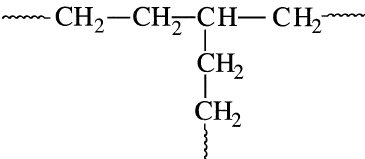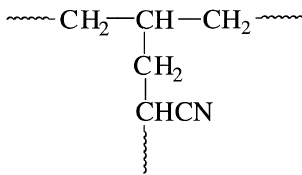
MONOMERS, POLYMERS, AND COPOLYMERS
 المؤلف:
sami matar & Lewis. F. Hatch
المؤلف:
sami matar & Lewis. F. Hatch
 المصدر:
Chemistry of PETROCHEMICAL PROCESSES
المصدر:
Chemistry of PETROCHEMICAL PROCESSES
 الجزء والصفحة:
p 302
الجزء والصفحة:
p 302
 14-9-2017
14-9-2017
 1827
1827
MONOMERS, POLYMERS, AND COPOLYMERS
A monomer is a reactive molecule that has at least one functional group (e.g. -OH, -COOH, -NH2, -C=C-). Monomers may add to themselves as in the case of ethylene or may react with other monomers having different functionalities. A monomer initiated or catalyzed with a specific catalyst polymerizes and forms a macromolecule—a polymer.
For example, ethylene polymerized in presence of a coordination catalyst produces a linear homopolymer (linear polyethylene):

A copolymer, on the other hand, results from two different monomers by addition polymerization. For example, a thermoplastic polymer with better properties than an ethylene homopolymer comes from copolymerizing ethylene and propylene:

Block copolymers are formed by reacting two different prepolymers, which are obtained by polymerizing the molecules of each monomer separately. A block copolymer made of styrene and butadiene is an important synthetic rubber:

Alternating copolymers have the monomers of one type alternating in a regular manner with the monomers of the other, regardless of the composition of the reactants. For example, an alternate copolymer of vinyl acetate and vinyl chloride could be represented as:

Random copolymers have the different monomer molecules distributed randomly along the polymer chain.
A polymer molecule may have just a linear chain or one or more branches protruding from the polymer backbone. Branching results mainly from chain transfer reactions and affects the polymer’s physical and mechanical properties. Branched polyethylene usually has a few long branches and many more short branches

Intentional branching may improve the properties of the product polymer through grafting. A graft copolymer can be obtained by creating active sites on the polymer backbone. The addition of a different monomer then reacts at the active site and forms a branch. For example, polyethylene irradiated with gamma rays and then exposed to a reactive monomer, such as acrylonitrile, produces a polyethylene-polymer with acrylonitrile branches:

Crosslinked polymers have two or more polymer chains linked together at one or more points other than their ends. The network formed improves the mechanical and physical properties of the polymer. Crosslinking may occur during the polymerization reaction when multifunctional groups are present (as in phenol-formaldehyde resins) or through outside linking agents (as in the vulcanization of rubber with sulfur).
 الاكثر قراءة في البترو كيمياويات
الاكثر قراءة في البترو كيمياويات
 اخر الاخبار
اخر الاخبار
اخبار العتبة العباسية المقدسة


